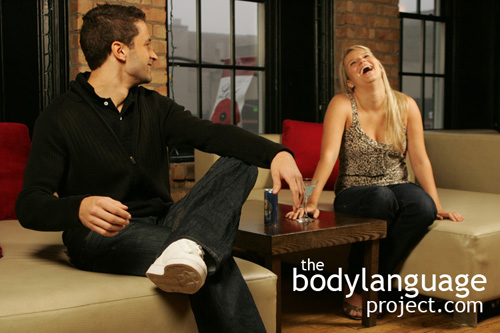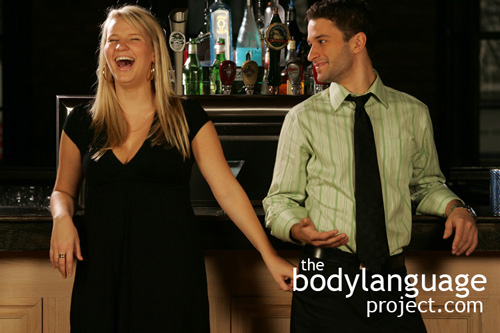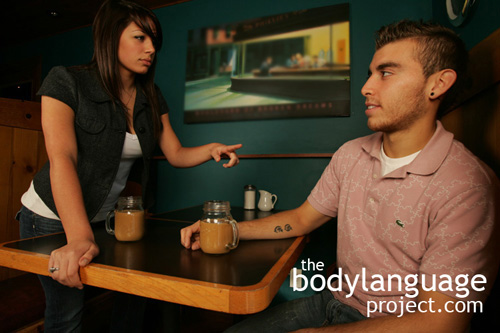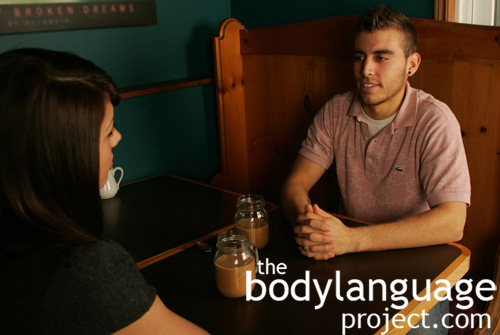Body Language of Leaning Against The Wall
 Cue: Leaning Against The Wall.
Cue: Leaning Against The Wall.
Synonym(s): Leaning Against A Chair, Leaning Against A Podium, Holding A Chair With Both Hands, Propping Up Against The Wall.
Description: Leaning against the wall with the shoulder or hand, or placing the hands on the back of the chair with it in front of the body. This cue is also replicated by leaning against a podium, or a car, grasping a hand rail, resting the hand of the edge of a countertop or any other way to gain support from the environment that serves no direct purpose.
In One Sentence: Leaning against the wall demonstrates that one is in need of extra support because one can not stand independently.
How To Use it: Leaning against the wall, when done in a casual way, can signal positive impressions and a relaxed attitude. However, if one wishes to create a dominant impression, one should not rely on other objects for support.
Leaning against the wall, or a bar top can be used as a crutch to activate memories of being held up. In an of itself, this will make one feel more at ease and secure. This is useful in novel environments or any other environment that creates discomfort. Thus, leaning against the wall is helpful as a security blanket and lends emotional “support.”
Context: General.
Verbal Translation: “I’m feeling insecure and lack the self confidence needed to stand under my own weight and balance, so I’m using the wall or chair as a crutch for stability and security.”
Variant: See Coffee Cup Barrier or Handbag Barrier, Ownership Gestures.
Cue In Action: a) They were ready to depart, so he quickly put his jacket on and stood up. Most of the rest in his party were slow to their feet so he awkwardly stood waiting in the middle of the restaurant. He pulled his chair in close to his body and put both hands on the back of the chair propping himself up. b) While speaking to a lovely lady, he braced himself against the wall with his shoulder. c) As they stood speaking with one another he reached out and placed his hand on the handrail for support.
Meaning and/or Motivation: Placing the hands on objects to support shows that a person feels insecure or lacks self confidence. A person will use the wall, table, chair, podium, railing, bar top or any object to provide stability and comfort. The object is turned into a crutch that provides a “security blanket” when people feel overexposed.
Leaning against the podium while presenting, a shoulder against the wall in an unfamiliar room, or two hands on the chair in a crowded room, are a few ways we convey uneasiness and discomfort. The objects help ground us and produce a strong wide base when our confidence fails us.
Cue Cluster: Often, this cue stands by itself because the object provides enough protection to keep a person from feeling insecure. One might watch for a person’s reliance on crutches to verify his level of insecurity. If a person holds a chair that is lower than normal, he may hunch up protecting his torso indicating additional insecurity.
Body Language Category: Barriers, Blocking or Shielding, Defensive body language, Security blankets, Stressful body language.
Resources:
Bernstein, Constance. Winning trials nonverbally: six ways to establish control in the courtroom. Trial. 1994. 30(1).61(5)
Balzarotti, Stefania ; Piccini, Luca ; Andreoni, Giuseppe ; Ciceri, Rita “I Know That You Know How I Feel”: Behavioral and Physiological Signals Demonstrate Emotional Attunement While Interacting with a Computer Simulating Emotional Intelligence. Journal of Nonverbal Behavior. 2014. 38(3): 283-299.
Brownell, Judi. Communicating with credibility: The gender gap. Cornell Hotel and Restaurant Administration Quarterly. 1993. 34(2): 52-61.
Carney, Dana R.; Amy J.C. Cuddy; Andy J. Yap. Power Posing: Brief Nonverbal Displays Affect Neuroendocrine Levels and Risk Tolerance. Psychological Science, 2010; 21 (10): 1363-1368.
Cuddy, Amy J.C., Caroline A. Wilmuth, and Dana R. Carney. The Benefit of Power Posing Before a High-Stakes Social Evaluation. Harvard Business School Working Paper, No. 13-027, September 2012.
Cashdan, Elizabeth. Smiles, Speech, and Body Posture: How Women and Men Display Sociometric Status and Power. Journal of Nonverbal Behavior. 1998. 22(4): 209-228.
Desteno, David ; Breazeal, Cynthia ; Frank, Robert H ; Pizarro, David ; Baumann, Jolie ; Dickens, Leah ; Lee, Jin Joo. Detecting the Trustworthiness of Novel Partners in Economic Exchange. Psychological Science. 2012. 23(12): 1549-1556.
Fatt, James P. T. It’s not what you say, it’s how you say it.(nonverbal communication). Communication World. 1999. 16(6): 37(4).
Fennis, Bob M. ; Stel, Marielle. The pantomime of persuasion: Fit between nonverbal communication and influence strategies. Journal of Experimental Social Psychology. 2011. 47(4): 806-810.
Gorkan Ahmetoglu, Viren Swami. Do Women Prefer “Nice Guys?” The Effect Of Male Dominance Behavior On Women’s Ratings. Social Behavior And Personality, 2012; 40(4), 667-672.
http://bodylanguageproject.com/articles/how-to-significantly-increase-male-attractiveness-with-simple-body-language-nice-guys-finish-last-once-again/
Hung, Iris W. and Aparna A. Labroo. From Firm Muscles to Firm Willpower: Understanding the Role of Embodied Cognition in Self-Regulation. Journal of Consumer Research. 2011 37(6): 1046-1064.
http://bodylanguageproject.com/articles/firm-muscles-lead-willpower/
Hareli, Shlomo; Noga Shomrat and Ursula Hess. Emotional Versus Neutral Expressions and Perceptions of Social Dominance and Submissiveness. Emotion. 2009 9(3): 378-384. DOI: 10.1037/a0015958
http://bodylanguageproject.com/articles/dominance-expression-conveyed-different-facial-expressions-men-women/
Koppensteiner, Markus ; Grammer, Karl. Body movements of male and female speakers and their influence on perceptions of personality. Personality and Individual Differences. 2011. 51(6): 743-747.
Koppensteiner, Markus ; Stephan, Pia ; Jäschke, Johannes Paul Michael. From body motion to cheers: Speakers’ body movements as predictors of applause. Personality and Individual Differences. 2015. 74: 182-185.
Lee Ann Renninger, T. Joel Wade, Karl Grammer. Getting that female glance: Patterns and consequences of male nonverbal behavior in courtship contexts. Evolution and Human Behavior. 2004; 25: 416–431.
http://bodylanguageproject.com/articles/part-i-how-to-read-male-sexual-body-language-a-study-for-women-and-the-men-who-wish-to-cheat-the-system/
Leigh, Thomas W. ; Summers, John O. An initial evaluation of industrial buyers’ impressions of salespersons’ nonverbal cues. Journal of Personal Selling & Sales Management. 2002. 22(1): 41(13).
Mehrabian, Albert ; Williams, Martin Mcguire, William J. (editor). Nonverbal concomitants of perceived and intended persuasiveness. Journal of Personality and Social Psychology. 1969. 13(1): 37-58.
Marsh, Abigail A; Henry H. Yu; Julia C. Schechter and R. J. R. Blair. Larger than Life: Humans’ Nonverbal Status Cues Alter Perceived Size. PLoS ONE. 2009. 4(5): e5707. doi:10.1371/journal.pone.0005707.
http://bodylanguageproject.com/articles/large-life-nonverbal-dominance-affects-perception-size/
Neumann, R., & Strack, F. (2000). Approach and avoidance: The influence of proprioceptive and exteroceptive cues on encoding of affective information. Journal of Personality and Social Psychology, 79, 39–48.
Navarro, Joe. A four-domain model for detecting deception: an alternative paradigm for interviewing. The FBI Law Enforcement Bulletin. 2003. 72(6): 19(6).
Park, Lora E.; Lindsey Streamer; Li Huang and Adam D. Galinsky. Stand Tall, But Don’t Put Your Feet Up: Universal and Culturally-Specific Effects of Expansive Postures On Power. Journal of Experimental Social Psychology. 2013; 49: 965–971.
http://bodylanguageproject.com/articles/are-expansive-postures-of-power-universal-or-cultural/
Rule, Nicholas, O.; Reginald B. Adams Jr.; Nalini Ambady and Jonathan B. Freeman. Perceptions Of Dominance Following Glimpses Of Faces And Bodies. Perception. 2012; 41: 687-706 doi:10.1068/p7023
http://bodylanguageproject.com/articles/people-can-read-dominance-split-second
Riskind, J. H., & Gotay, C. C. (1982). Physical posture: Could it have regulatory or feedback effects upon motivation and emotion? Motivation and Emotion, 6, 273–296.
Roll, William V. ; Schmidt, Lyle D. ; Kaul, Theodore J. Berdie, Ralph F. (editor). Perceived interviewer trustworthiness among black and white convicts. Journal of Counseling Psychology. 1972. 19(6): 537-541.
Ryan, Mary E. Good nonverbal communication skills can reduce stress. (Law Office Management). Trial. 1995. 31(1): 70(5).
Stepper, S., & Strack, F. (1993). Proprioceptive determinants of emotional and nonemotional feelings. Journal of Personality and Social Psychology, 64, 211–220.
Schubert, Thomas W. and Koole, Sander L. The embodied self: Effects of making a fist on the implicit and explicit self-concept of men and women. Journal of Experimental Social Psychology. 2009. 45: 828-834.
Sturman, Edward D. Invluntary Subordination and Its Relation to Personality, Mood,
and Submissive Behavior. Psychological Assessment. 2011. 23(1): 262-276 DOI: 10.1037/a0021499
http://bodylanguageproject.com/articles/nonverbal-submission-men-women-depression-critical-examination-use-disuse-submission/
Tracy, J. L., & Matsumoto, D. (2008). The spontaneous expression of pride and shame: Evidence for biologically innate nonverbal displays. Proceedings from the National Academy of Sciences, 105(33), 11655–11660.
Tracy, J. L., & Robins, R. W. (2007). The prototypical pride expression: Development of a nonverbal behavior coding system. Emotion, 7(4), 789–801.
Yap, Andy J.; Abbie S. Wazlawek, Brian J. Lucas, Amy J. C. Cuddy, Dana R. Carney. The Ergonomics of Dishonesty: The Effect of Incidental Posture on Stealing, Cheating, and Traffic Violations, 24(11); 2281-2289.
http://bodylanguageproject.com/articles/body-posture-physical-environment-determine-feelings-and-behaviour-study/
Yuksel, Atila. Nonverbal Service Behavior and Customer’s Affective Assessment. Journal of Quality Assurance in Hospitality & Tourism. 2008. 9(1): 57-77.









